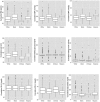Cardiovascular Disease Risk Factor Burden During the Menopause Transition and Late Midlife Subclinical Vascular Disease: Does Race/Ethnicity Matter?
- PMID: 32063114
- PMCID: PMC7070180
- DOI: 10.1161/JAHA.119.013876
Cardiovascular Disease Risk Factor Burden During the Menopause Transition and Late Midlife Subclinical Vascular Disease: Does Race/Ethnicity Matter?
Abstract
Background The extent to which cardiovascular disease (CVD) risk factors across the menopause explain racial/ethnic differences in subclinical vascular disease in late midlife women is not well documented and was explored in a multi-ethnic cohort. Methods and Results Participants (n=1357; mean age 60 years) free of clinical CVD from the Study of Women's Health Across the Nation had common carotid artery intima-media thickness, interadventitial diameter, and carotid plaque presence assessed by ultrasonography on average 13.7 years after baseline visit. Early to late midlife time-averaged cumulative burden of traditional CVD risk factors calculated using serial measures from baseline to the ultrasound visit were generally less favorable in black and Hispanic women compared with white and Chinese women, including education and smoking status and time-averaged cumulative blood pressure, high-density lipoprotein cholesterol, and fasting insulin. Independent of these risk factors, BMI, and medications, common carotid artery intima-media thickness was thicker in black women, interadventitial diameter was wider in Chinese women, yet plaque presence was lower in black and Hispanic women compared with white women. CVD risk factor associations with subclinical vascular measures did not vary by race/ethnicity except for high-density lipoprotein cholesterol on common carotid artery intima-media thickness; an inverse association between high-density lipoprotein cholesterol and common carotid artery intima-media thickness was observed in Chinese and Hispanic but not in white or black women. Conclusions Race/ethnicity did not particularly moderate the association between traditional CVD risk factors measured across the menopause transition and late midlife subclinical vascular disease. Unmeasured socioeconomic, cultural, and nontraditional biological risk factors likely play a role in racial/ethnic differences in vascular health and merit further exploration.
Keywords: atherosclerosis; cardiovascular disease risk factors; menopause; race and ethnicity; women.
Figures



Similar articles
-
Low socioeconomic status over 12 years and subclinical cardiovascular disease: the study of women's health across the nation.Stroke. 2014 Apr;45(4):954-60. doi: 10.1161/STROKEAHA.113.004162. Epub 2014 Feb 27. Stroke. 2014. PMID: 24578209 Free PMC article.
-
Abuse and subclinical cardiovascular disease among midlife women: the study of women's health across the nation.Stroke. 2014 Aug;45(8):2246-51. doi: 10.1161/STROKEAHA.114.005928. Epub 2014 Jul 17. Stroke. 2014. PMID: 25034715 Free PMC article.
-
Simple physical performance measures and vascular health in late midlife women: the Study of Women's Health across the nation.Int J Cardiol. 2015 Mar 1;182:115-20. doi: 10.1016/j.ijcard.2014.12.042. Epub 2014 Dec 23. Int J Cardiol. 2015. PMID: 25577747 Free PMC article.
-
Weight gain during midlife: Does race/ethnicity influence risk?Maturitas. 2024 Jul;185:108013. doi: 10.1016/j.maturitas.2024.108013. Epub 2024 Apr 30. Maturitas. 2024. PMID: 38703595 Review.
-
Disparities in Reproductive Aging and Midlife Health between Black and White women: The Study of Women's Health Across the Nation (SWAN).Womens Midlife Health. 2022 Feb 8;8(1):3. doi: 10.1186/s40695-022-00073-y. Womens Midlife Health. 2022. PMID: 35130984 Free PMC article. Review.
Cited by
-
Racial and ethnic influences on carotid atherosclerosis: Epidemiology and risk factors.SAGE Open Med. 2024 Jun 23;12:20503121241261840. doi: 10.1177/20503121241261840. eCollection 2024. SAGE Open Med. 2024. PMID: 39045542 Free PMC article. Review.
-
Smoking and secondhand smoke exposure and carotid intima-media thickness: Baseline data from the Aidai Cohort Study in Japan.Tob Induc Dis. 2024 Jan 19;22. doi: 10.18332/tid/175632. eCollection 2024. Tob Induc Dis. 2024. PMID: 38250629 Free PMC article.
-
Suboptimal Control of Small Dense Low-Density Lipoprotein Cholesterol Is Associated With Coronary Plaque Progression: An Intravascular Ultrasound Study.J Am Heart Assoc. 2025 Mar 4;14(5):e038580. doi: 10.1161/JAHA.124.038580. Epub 2025 Feb 26. J Am Heart Assoc. 2025. PMID: 40008507 Free PMC article.
-
Adverse generational changes in obesity development converge at midlife without increased cardiometabolic risk.Obesity (Silver Spring). 2021 Nov;29(11):1925-1938. doi: 10.1002/oby.23260. Epub 2021 Sep 13. Obesity (Silver Spring). 2021. PMID: 34514749 Free PMC article.
-
Cardiovascular disease (CVD) risk scores, age, or years since menopause to predict cardiovascular disease in the Women's Health Initiative.Menopause. 2021 May 3;28(6):610-618. doi: 10.1097/GME.0000000000001753. Menopause. 2021. PMID: 33950030 Free PMC article. Clinical Trial.
References
-
- Benjamin EJ, Virani SS, Callaway CW, Chamberlain AM, Chang AR, Cheng S, Chiuve SE, Cushman M, Delling FN, Deo R, de Ferranti SD, Ferguson JF, Fornage M, Gillespie C, Isasi CR, Jimenez MC, Jordan LC, Judd SE, Lackland D, Lichtman JH, Lisabeth L, Liu S, Longenecker CT, Lutsey PL, Mackey JS, Matchar DB, Matsushita K, Mussolino ME, Nasir K, O'Flaherty M, Palaniappan LP, Pandey A, Pandey DK, Reeves MJ, Ritchey MD, Rodriguez CJ, Roth GA, Rosamond WD, Sampson UKA, Satou GM, Shah SH, Spartano NL, Tirschwell DL, Tsao CW, Voeks JH, Willey JZ, Wilkins JT, Wu JH, Alger HM, Wong SS, Muntner P; American Heart Association Council on Epidemiology and Prevention Statistics Committee and Stroke Statistics Subcommittee . Heart disease and stroke statistics—2018 update: a report from the American Heart Association. Circulation. 2018;137:e67–e492. - PubMed
-
- Matthews KA, Sowers MF, Derby CA, Stein E, Miracle‐McMahill H, Crawford SL, Pasternak RC. Ethnic differences in cardiovascular risk factor burden among middle‐aged women: Study of Women's Health Across the Nation (SWAN). Am Heart J. 2005;149:1066–1073. - PubMed
-
- Lloyd‐Jones DM, Sutton‐Tyrrell K, Patel AS, Matthews KA, Pasternak RC, Everson‐Rose SA, Scuteri A, Chae CU. Ethnic variation in hypertension among premenopausal and perimenopausal women: Study of Women's Health Across the Nation. Hypertension. 2005;46:689–695. - PubMed
Publication types
MeSH terms
Grants and funding
LinkOut - more resources
Full Text Sources
Medical

